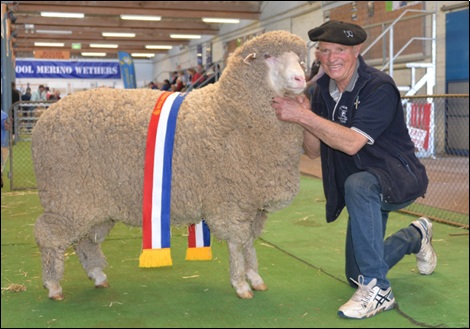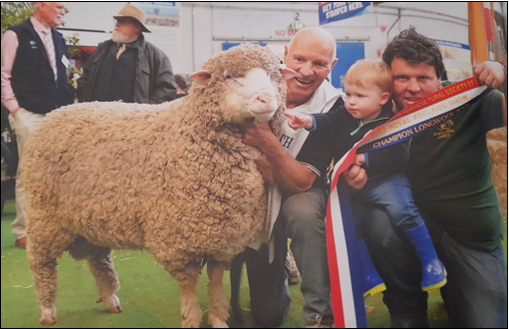Like most boys I didn’t know much about sheep and livestock until we experienced that exciting time of moving from the Parndana camp onto the block when dad selected and was granted section 6 hundred of McDonald in December 1957. Dad (Vincent McArdle) was a WW II solider settler on KI. At the time the property wasn’t ready for major stocking so finally in 1959 the first polwarth sheep were purchased and arrived on property. He had been advised to run this breed by Tom Carty (a solider settler who previously managed Goldsbrough Morts Woolstore at Port Adelaide). Dad also respected Ron Nunn as a very successful settler sheep farmer who ran Polwarths, so the dye was cast. Dad would run Polwarth sheep on his property.
As youngsters we were involved with the sheep jobs e.g. tailing (getting in the way), crutching/ shearing times, and other sheep work with dad on the farm. At this stage of life, I loved the lambs. On looking at old photographs, dad’s flock did look like a very well-bred sheep flock in my eyes, and I guess that’s how my interest in sheep breeding started.

David McArdle with Big Ike, 2019 Adelaide Champion Polwarth. Big Ike lost the Longwool Interbreed by a count back.
My mother guided me away from farming and my first job on leaving school was bookkeeping at a stock agency. I later joined Elders metro at Gepps Cross saleyards (outskirts of Adelaide) which provided me with tremendous livestock experience and training. Dad had a major thrombosis in 1968 and my mother a hysterectomy, so I came back to the farm and sheep, rolled up my sleeves and got to work. Things were a little run down and prices on farm production were disgraceful.
Outsiders advised me to breed out of Polwarths and use Merinos. Good experience but a total WRONG move. I lost the ‘doing and mothering ability’ of our flock, so by 1978 I was ready for Polwarth rams again. With much difficulty, I finally purchased several small lots of ewes and several rams from Lyall Starkey and Mount Alma. This has stuck in my mind as now I try to move heaven and earth to supply ewes to people who want them and hope they don’t waste their opportunity; but sad to say many do.
I’ve found that your sheep breed should suit your climate and environment. A HUGE THING. Lynne and I had many discussions about sheep breeding and where we look to go in the future. In my opinion the Border Leicester/ Merino cross was and still is the competition of the Polwarth breed. We both believed strongly that with tinkering and patience our Polwarths would be superior commercially and now I know they are. I believe my wool is superior to these crossbred flocks and our flocks’ mothering and lamb finishing is a least equal with a lambing percentage that is also comparable. Our wool weights may be slightly below pure Merino flocks, but in all other factors Polwarths are very much superior.
When school students come to our property to do a sheep classing course, I tell them that one of the most enjoyable things about breeding Polwarth sheep is the ability for your flock to produce high quality fleece with a ewe that produces an excellent lambing %, whilst breeding a lamb with growth rate and finishing ability. Many other breeds only worry about wool growing or lamb growth only. To me this has been a huge challenge during my lifetime.

Along the way, especially in the early days we received much help from John and Barbara Dohle, Lyall Starkey, Eric Snr and Ike Ashby; All very good friends to this day. I will never forget a mob of 800 lambs at Mount Alma. ABSOLUTELY BEAUTIFUL. Lynne and I were very impressed, this gave me a target to achieve at the time.
My flock is totally commercially orientated but we have done a huge amount of work structurally on feet and body. Hairiness was something polwarths had when I was young and also curly sharp horns. I still remember when we were holding lambs during tailing for dad and my chest would be quite bruised from the sharp horns! I think this is the reason that I have been breeding and buying pure poll rams since 1971. At this time poll rams were frowned upon by many as it was felt hornies were vastly superior for both growth rates, wool quality and production. Teeth were an issue in some flocks, we have tried to correct many of these and improve size and growth rates. I sometimes look at my flock and wish I had these animals 50 years ago. They would have been hugely popular on Kangaroo Island back then.
The Taljar stud still gives me a good reason to wake up and get out of bed every morning. Another thing the association has done for me is the number of genuine friendships with others that I have developed over the past 25 years, both within and outside our breed. Going to shows both in South Australia and Victoria gives you something to think and talk about all year. Planning for the event again makes life interesting. The media exposure and catching up with friends is a huge part of the show scene. I do hope as a small breed now we are not forced out of this scene by the expense involved. Much as I love the show scene the costs of showing and certainly accommodation is now very daunting. It’s ok if your selling 100+ rams but who in our breed is doing that I ask you. The thing is having registered sheep has given me access to these things at major shows around Australia. Something else to thank my Polwarth sheep for, to allow me to do these things, still maintain being commercially viable and meet all these people with like interests.
The Major highlights for me as a Polwarth breeder during my time include:
- First Champion at Adelaide Show, 2008
- First Ewe Champion at the Australian Sheep and Wool Show, 2008
- Losing on a countback, therefore receiving Reserve Champion Under 1.5 Group Breeders Group, Australian Sheep and Wool Show, 2015
- Supreme Champion Polwarth at the Australian Sheep and Wool Show with a ewe, 2016
- Champion Longwool Interbreed ram at Adelaide Show, 2017

Taljar Lynne, 2017 Supreme Champion Polwarth at ASWS, Bendigo pictured with from left Talisa, David, Jared and Lynne McArdle.
Another good experience the association gave me was 3 years of being President. I really enjoyed this period and at the time we did something that are beneficial to this day. Little things like this boost your confidence and approach to life. I would very much like to thank the Polwarth association for making me a life member last September. I feel very honoured and hope I can still assist the association whenever I’m able. I hope I can still show my sheep regularly but maybe not the numbers of the past. It is a big trip to Bendigo, and I do need a co-driver. The difficulty of this trip is living on KI and an hour from the ferry plus an hour and a bit on the boat, add the unreliability of the service means we are sometimes stuck at Bendigo or at home unable to cross. Like the time the show was cancelled at the last moment due to COVID, but we couldn’t leave Bendigo because the ferry was cancelled for 2.5 days, then struggled to cross the border and come home to two weeks isolation.
It has been unbelievable our success at many shows over the last 25 years. To me, showing is the pinnacle, putting you and your stud in front of others tells you how much you are going forward or back in your breeding program by comparing your animals against other breeders and breeds. Judges are but one man, his ideas are on the day, whilst you are breeding to your eye and your properties environment. Don’t be discouraged by some bad results. Keep to your breeding plan but be open to others and their opinion. Learn to sort the wheat from the chaff.
Once again, I must thank my father for his vision of the future thus enabling me to experience to life I’ve had and enabling me to hone my breeding skills and develop the flock that I now have. I have found that the Polwarth sheep has given to me their all financially, and I have tried to put back to them in return. I learned early that you only get out of life what you put into it.
In my opinion, the future is a little shaky at the moment. The breed is too good to just disappear into history. We need to bring our breed into the 21st century.
To survive the following needs to be done:
- Improved marketing and enthusiasm for Polwarth sheep and to increase media interest in our animals and show what our can animals produce.
- Increased market share by showing our increased wool cutting with quality, lamb raising and lambing percentages and growth rates.
- Build a strong association and leadership in our Polwarth industry
- Other growers must look at a Polwarth and see that they are commercially viable, and they can make money from the animals
- The quality of the breed must be lifted so the Polwarth moves forward. They can be crossed with all prime lamb rams. Our sheep must produce commercially.
We have been pleased that several younger people bought at our recent sales. Hopefully they will expand in the future. Younger breeders are essential for our future. Most reports we are receiving are very positive at this stage.
Finally, my best wishes to all the fellow and future breeders of Polwarth sheep. The fellowship of our group is wonderful. Our breed is the best in the world as dual purpose, farmer friendly, highly productive animals in the paddock.

Taljar Ray, Longwool Interbreed Champion, Adelaide 2017 with David and Jared McArdle



